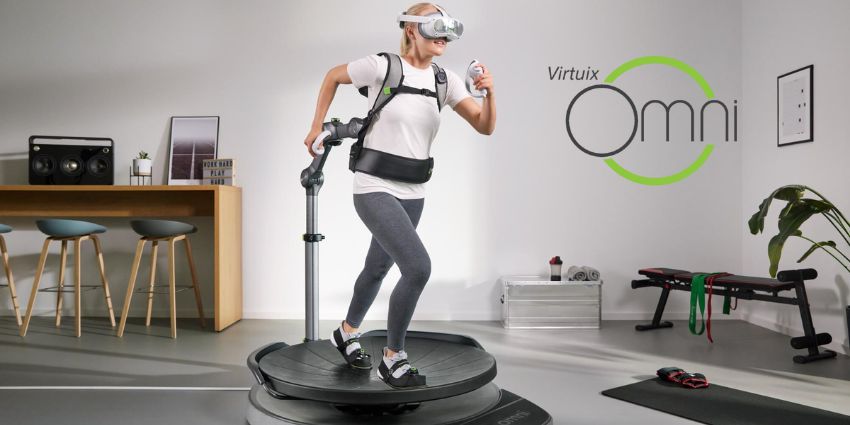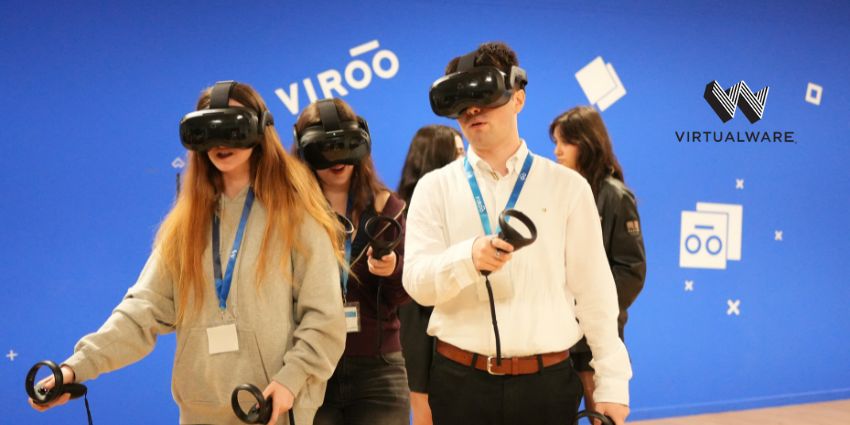The Virtuix Omni One “VR platform” has arrived, promising extended reality enthusiasts a new virtual experience.
For a while now, innovators in the XR landscape have been searching for ways to make virtual experiences feel more realistic and immersive. One of the main challenges to overcome involves figuring out how to give users a way to move freely in VR. No one wants to bump into walls when walking around wearing a VR headset.
Virtuix, an XR pioneer, has been focusing on this issue for some time with the development of omnidirectional treadmills. These treadmills give users the freedom to walk and run in an infinite VR space while ensuring they stay firmly situated in one “real world” spot.
Though they’re a little more expensive (and bulky) than some other solutions for VR locomotion, these omnidirectional treadmills can improve user safety, reduce VR sickness, and even enable more engaging, memorable XR experiences.
The Omni One VR platform represents the next stage in Virtuix’s quest to deliver true freedom of movement in VR. Here’s everything you need to know about the kit.
Quick Verdict, Pros and Cons
The Virtuix Omni One is a comprehensive kit consisting of an omnidirectional treadmill, a set of haptic feedback controllers, and a PICO 4 Enterprise headset. It’s a fantastic solution for those seeking deeper immersion and freedom of movement in VR, although it does take some getting used to. The biggest downside is its lack of compatibility with enterprise-focused apps.
Pros:
- Comfortable design for the headset and treadmill
- High-quality visuals and tracking from PICO
- Excellent versatility for users of all sizes
- Integrated safety mechanisms for protection
Cons:
- Slight learning curve for beginners
- Some headset limitations
- Lacking access to enterprise-level apps
What is the Virtuix Omni One? Overview and Specs
The Virtuix Omni One solution builds on the XR company’s previous successes in the omnidirectional treadmill landscape.
Notably, you’re not just getting one of Virtuix’s treadmills in this kit, which allows you to run, walk, crouch, kneel, and move around in 360 degrees.
The package also includes the PICO 4E headset, one of the most impressive enterprise-grade headsets created by the Bytedance-owned “PICO” brand in the last few years.
The headset is equipped with a Qualcomm XR2 processor, and offers an impressive 2160 x 2160 resolution per eye, up to 90Hz refresh rate, and 6DoF tracking. You can check our full review of the PICO 4 here, for more insights.
The kit also includes a set of ergonomic “HyperSense” controllers, which have built-in responsive haptics for deeper immersion. The full kit costs a hefty $2,595 plus shipping, although payment plans are available.
Here’s a quick rundown of the specs for both the Omni One treadmill and the PICO 4 headset.
Omni One Treadmill Specs:
- Weight: 150 lbs
- Size: 48″w x 60″d x 48″h
- User height support:4” to 6.4”
- User weight support: Up to 250 lbs
- Charging; USB-C
- Vest size: Up to 46-inch waist
VR Headset Specs:
- CPU: 64-bit, 8-core Qualcomm XR2
- RAM: 8 GB DDR5
- Storage: 256GB
- Resolution: 2160 x 2160 per eye
- Field of view: 105 degrees
- Tracking: 6DoF controller tracking, plus eye and face tracking
- Interaction: Full-color passthrough
- Battery: 5300 mAh capacity
The Comfort Factor: Using Virtuix Omni One
Ultimately, if you’ve never used a treadmill designed for virtual reality, you’ll find the Omni One experience a little unusual. The treadmill itself certainly isn’t uncomfortable to use. It comes with an articulated “support arm” to help keep you upright (and safe) when you’re running around and kneeling in VR, which is a nice touch.
Plus, you get a padded strap that secures you from behind, so there’s nothing to obscure your movements. You can move pretty freely, without feeling restricted, throw your arms around, kick your legs, and much more.
Still, moving around in VR on a treadmill with virtually no friction or tread on the surface takes some getting used to. The platform feels quite slippery, mainly when using the low-friction covers that come with it. That’s intended to help you feel like you’re moving more naturally, but it does give you the initial sense that you’re going to fall over at any moment.
Plus, while walking forward is simple enough, once you get used to it, shuffling backward and moving in different directions is a little more complex. You might rely on that robotic arm to stop you from crashing to your knees.
The Added Benefit of the PICO 4
The good news is that the enterprise-quality PICO headset that comes with the device is excellent at keeping up with your movements. It’s integrated trackers and high-resolution screens help to contribute to a highly natural experience moving around in VR. However, I do think a more advanced headset, like the PICO 4 Ultra, might make the experience even better.
Additional tracking capabilities would reduce your reliance on controllers, which can be tough to navigate when focusing on not falling over.
A stronger chipset would also reduce the risk of lag when you’re moving around at speed, which could be crucial for people who suffer from VR sickness. Fortunately, you get full-color pass-through to check on your surroundings occasionally.
Apps and Software for the Virtuix Omni One
Despite the initial complexity of getting used to using an omnidirectional treadmill, comfort isn’t the biggest issue facing the Virtuix Omni One, in my opinion. The major problem most users will face is that there aren’t a huge number of apps and tools you can use with your treadmill.
There’s the Omni One app, which lets you track your steps, distance covered, and calories burned when you’re “working out in VR”. Beyond that, the Omni One doesn’t run on the same platforms as competitors like the Meta Quest 3, which means your app options are limited.
The kit is designed to work best with games on the Omni One Store. Right now, there are about 30+ options to choose from, but none of these are tailored to enterprise use cases. That’s a shame, considering Virtuix chose an enterprise-level headset for its kit.
You can plug your VR treadmill and headset into a computer to access Steam VR apps, but they won’t all be configured to take advantage of the full-body movement you’ll have access to. I think Virtuix is missing an incredible opportunity here.
After all, Virtual Reality treadmills probably won’t be a standard accessory for most consumers. However, they offer a lot of potential in the enterprise space, where companies want to invest in immersive experiences for training.
With accessible, flexible apps and metaverse as a service solution, companies could use platforms like the Virtuix Omni One to design unique educational experiences for employees. Alternatively, they could offer unique access to digital twins of physical office and warehouse spaces.
There’s also a huge opportunity for customer service. Real estate and hospitality companies could allow customers to walk around spaces and explore environments with complete freedom.
The Verdict: Is the Virtuix Omni One the Future of VR?
Ultimately, virtual reality treadmills are still a novel purchase for most users. The average consumer probably isn’t going to drop nearly $3,000 on a treadmill and headset, especially if they’ll only be able to use that kit with a small selection of apps.
High price tags aren’t always a deterrent for some consumers. The Apple Vision Pro is still earning sales, after all. However, most people would prefer to spend extra on a cutting-edge headset rather than a large VR accessory.
That’s not to say consumers aren’t interested in accessing more freedom of motion in VR. Even before the Omni One kit was released, it had a waitlist consisting of nearly 35,000 subscribers.
Virtuix might be missing out on a fantastic market opportunity, though. In the enterprise, kits like the Virtuix Omni One may hold more potential, particularly for training and customer service.







